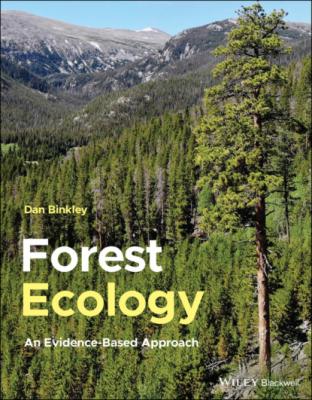Forest Ecology. Dan Binkley
Читать онлайн.| Название | Forest Ecology |
|---|---|
| Автор произведения | Dan Binkley |
| Жанр | Биология |
| Серия | |
| Издательство | Биология |
| Год выпуска | 0 |
| isbn | 9781119704416 |
Table of Contents
1 Cover
5 Preface How Do We Come to Understand Forests? How Confident Should You Be? All Forest Ecology Fits Into a Framework and a Method A Picture May Be Worth 1000 Words, But a Graph Can Be Worth Even More The Most Important Points to Understand from Figures B and C Are Not About Precipitation or Temperature Confidence Bands Around Trends Come in Two Types The Stories in This Book Have Two Pieces, Told in Three Ways Forests Are Complex Systems That Are Not Tightly Determined
7 CHAPTER 1: The Nature of Forests Forest Ecology Deals with Individual Trees Across Time Many Processes Occur in a Tree Every Hour Tree Physiology Follows Daily Cycles Trees Must Cope with Seasonal Cycles Through Each Year Trees Grow and Reproduce at Times Scales of a Century The Story of Forests Is More than the Sum of the Individual Trees, Because Interactions Are So Strong The Coweeta Forests Aren't the Same as Two Centuries Ago Across Dozens of Generations of Trees, Almost Everything Changed at Coweeta The Futures of the Tree and the Forest Will Depend on Both Gradual, Predictable Changes and Contingent Events Ecological Afterthoughts: Is a Forest an Organism?
8 CHAPTER 2: Forest Environments Climate Influences Where Forest Occur, and How They Grow Warmer Forests Have More Species of Trees Chemical and Biological Reactions Go Faster with Increasing Temperature Temperature is the Balance Point Between Energy Gains and Losses All Objects Shine; Hot Objects Shine Brightly Incoming Sunlight Decreases in Winter and at Higher Latitudes Forests Receive Shortwave Sunlight, and Shine off Longwave Radiation Temperatures Decline with Increasing Latitude Temperatures Increase at Lower Elevations Temperature Variation Over Time, and Across Space, Strongly Influences Forest Ecology Temperature Strongly Influences Phenology and Growth Forests Use Very Large Amounts of Water Water Flows Down Gradients of Potential, Which Sometimes Means Going Up Wind Shapes Trees and Forests Events and Interactions Are More Important Than Averages and Single Factors Fires Depend on Temperature, Water, Winds Droughts Affect Trees, Beetles, Forest Structure and Fire Intensity Weather Events Can Matter More than Averages Ecological Afterthoughts
9 CHAPTER 3: Evolution and Adaptation in Forests What's in a Name? The Core Idea of Evolution Is the Combination of Variation, Failure, and Innovation Darwin Could Not Explain Why Variations Occurred, or Why They Were Passed on to Offspring Does Selection Work on Species or on Genes, or Is This Only a Chicken‐and‐Egg Question? Biology Operates from a Simple Story of DNA to Incredible Complexity of Proteins and Biochemistry Why Are There Only Two Species of Tulip Poplar, and Why Are They 12 000 km Apart? Tall Growth Requires Strong Stems The First Trees from Seeds Were Gymnosperms Collaboration with Insects Helped Angiosperms Take over the Planet The Highest Diversity Is in Tropical Rain Forests Do all Trees Need to Have Trunks? Some Broadleaved Trees Make Fertilizer Out of Thin Air What's the Largest Tree in the World? History Has No Need to Repeat Itself Critchfield Spruce Melted Away at the End of the Last Ice Age Ponderosa Pine Went from Obscurity to Prominence in Just a Few Thousand Years
